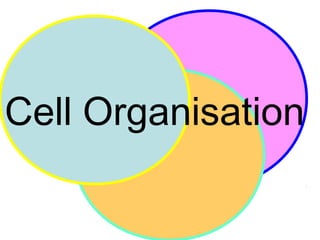
CHAPTER 2: CELL ORGANISATION
- 2. • Unicellular organisms are organisms which consist of single cell. • Although simple, they are able to perform all vital functions and living processes within a cell. • They can feed, respire, excrete and move. • They are sensitive to external and internal conditions, and are able to reproduce and grow.
- 3. Amoeba sp.
- 4. Amoeba sp. Habitat • Live in freshwater lakes, are also abundant in damp soil General characteristics • Enclosed by a plasma membrane. • Changes its shape constantly as it meets obstacles and responds to stimuli. Living processes • Feeding • Locomotion • Respiration • Excretion • Respond to stimuli • Reproduction
- 5. LivingLiving processes ofprocesses of amoeba sp.amoeba sp. Feeding Locomotion Reproduction Respiration Excretion Responses to stimuli
- 7. Cell Tissue Organ System Organism The smallest unit of life capable of carrying out all the functions of living things A group of cells of the same type that perform a specific function in organism Several types of tissue that carry out a particular function Several organs working together to perform a function All the systems make up a multicellular organism.
- 8. Cell organisation in the formation of tissues, organs and systems in animals
- 9. Some of the humans cells and their functions Cell Function Muscle cell Able to contract and relax and are involved in movement White blood cell Involves in defence of the body against diseases Red blood cell Transports oxygen Nerve cell Receives and sends out nerve impulses Sperm Fertilises the ovum
- 10. There are 4 major types of tissues in animals: • Epithelial tissues • Muscle tissues • Connective tissues • Nerve tissues
- 11. Epithelial Tissue • Form a skin surface and protect the tissue beneath it. • Form a lining layer for tubes or lines the cavities of the body. • Protect against infection, mechanical injuries and dehydration. • Undergo changes to form glands.
- 13. Muscle Tissue • Most abundant tissue in the body Smooth muscle Skeletal muscle Cardiac muscle • Contraction and relaxation for involuntary body activities (peristalsis along digestive tract) • Voluntary movements • Contract and relax to move the bone • Contract to pump blood to all parts of the body. • Involuntary movements
- 15. Connective tissue • Hold the body together. • For example, bone, cartilage, blood, tendons, ligament.
- 17. Nerve Tissue • Transmits and coordinates messages around the body.
- 19. Discards toxic waste products Produces off spring Absorbs and transports oxygen and discards carbon dioxide Breaks down complex food into simple substances for easy absorption by body cells Systems
- 20. Transports food substances, oxygen, hormones and others to the entire body Defends the body against disease Provides bodily support and protection to solf internal organs Produces hormones that control the bodily activities
- 21. Skin surface to protects the tissue beneath it. Coordinates and controls all bodily activities related to impulses and reactions Helps in movement of the body.
- 23. Some of the plants cells and their functions Cell Function Parenchyma cell For support and storage Xylem Transports water and mineral salts Sieve tube element Transports organic product of photosynthesis Companion cell Regulates the metabolic activity of sieve tube element Epidermal cell For protection and covering of other cells beneath
- 24. Tissues of plants Meristemic tissue permanent tissue Epidermal tissues Ground tissues Vascular tissues • Small cell, thin walls, large nuklei, dense cytoplasm, no vacuole. • Young, actively dividing • Form a layer to cover, protect entire surface of plant and reduces water loss • Provides support and strengthens the plants • Transports water, food and support
- 25. Bears flowers, fruits, buds and leaves Anchors the plant, absorbs water and mineral, stores food.
- 28. Excretion ofExcretion of AmoebaAmoeba spsp.. • The contractile vacuole is involved in osmoregulation. • Water diffuses into the cell and fills the contractile vacuole. • When the vacuole is filled to its maximum size, it contracts to expel its contents.
- 29. Locomotion • Amoeba sp. moves by cytoplasmic projection, that is, by extending its pseudopodia or ‘false feet’ and anchoring the tips to the ground. pseudopodium
- 30. Phagocytosis
- 31. Binary fission • Asexual reproduction. • When food abundant, binary fission. • When the amoeba reaches a maximum size, the nucleus divides into two and the cytoplasm constricts, forming two new amoeba.
- 32. Respiration of Amoeba sp. • Exchange of oxygen and carbon dioxide occurs through the plasma membrane. O2 O2 CO2 CO2
- 33. Responses to stimuliResponses to stimuli • Amoeba sp. reacts by retreating from adverse stimuli such as bright light and acidic solution. • In contrast, favourable stimuli such as contact with food, cause it to move towards the stimuli. Food Light acids